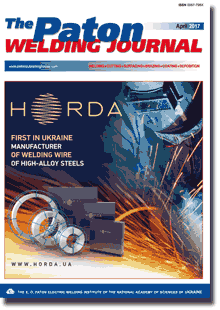| 2017 №04 (06) |
DOI of Article 10.15407/tpwj2017.04.07 |
2017 №04 (08) |

The Paton Welding Journal, 2017, #4, 35-38 pages
Formation of welded joints of magnesium alloys in pulse multipass electron beam welding
V.M. Nesterenkov, L.A. Kravchuk, Yu.A. Arkhangelsky and Yu.V. Orsa
E.O. Paton Electric Welding Institute, NASU 11 Kazimir Malevich Str., 03680, Kiev, Ukraine. E-mail: office@paton.kiev.ua
Abstract
The work studies the peculiarities of formation of the joints of cast magnesium alloy ML10 of 8 mm thickness in pulse vacuum electron beam welding. The investigations were carried out on specimens of alloy of Mg–Zn-Zr–Nd doping system at optimum pulse repetition frequency and increased welding rate. It is determined that welding in several passes with step increase of electron beam current in the pulse is necessary for providing high quality of formation and strength properties of welded joints. It is shown that strength characteristics of welded joints are at the level not lower than 92 % of similar base metal properties. 11 Ref., 1 Table, 5 Figures.
Keywords: electron beam welding, magnesium alloys, pulse welding mode, welded joint strength, thermal cycle, weld metal microstructure, HAZ, base metal
Received: 06.03.17
Published: 17.04.17
References
- Matting, A., Sepold, G. (1967) Beitrag zum Schweissen mit Impuls-gesteuerten Elektronenstrahlen.: DVS-Bericht 1. Schweisstechnik, 123–133.
- Indenbrand, H.-D., Schlenk, R. (1970) Untersuchungen zum Elektronenstrahlimpulsschweissen. Ibid., 6, 253–257.
- Khudyshev, A.F., Slavin, G.A. (1971) Investigation of technological peculiarities of pulse electron beam welding of thin sheets. Fizika i Khimiya Obrabotki Materialov, 3, 13–19.
- Khokhlovsky, A.S., Lopatko, A.P., Krylov, V.G. (1978) Weldability of magnesium-based alloy by electron beam. In: Electron beam welding. Moscow: House of Sci.-Techn. Information, 68–72.
- Nazarenko, O.K., Nesterenkov, V.M., Neporozhny, Yu.V. (2001) Design and electron beam welding of vacuum chambers. The Paton Welding J., 6, 40–42.
- Paton, B.E., Nazarenko, O.K., Nesterenkov, V.M. et al. (2004) Computer control of electron beam welding with multi-coordinate displacements of the gun and workpiece. Ibid., 5, 2–5.
- (1978) Magnesium alloys. In: of A.A. Baikov Institute of Metallurgy. Moscow: Nauka.
- Kanz, H.G. (1959) Eigenspannungen verwerfungen und Masshaltigkeit beim Schweissen. Schweissen und Scheiden, 11(3), 139–142.
- Majstrenko, A.L., Nesterenkov, V.M., Strashko, R.V. et al. (2016) Hybrid technology combining electron beam welding and friction stir welding in the processes of repair of aircraft structure elements of magnesium alloys. The Paton Welding J., 5/6, 91–97. https://doi.org/10.15407/tpwj2016.06.16
- Bondarev, A.A., Nesterenkov, V.M. (2013) Investigation of weldability of magnesium alloy MA2 by electron beam in vacuum. Kompressornoe Energeticheskoe Mashinostroenie, 2, 21–28.
- Bondarev, A.A., Nesterenkov, V.M. (2014) Technological peculiarities of welding of wrought magnesium alloys by electron beam in vacuum. The Paton Welding J., 3, 16–20. https://doi.org/10.15407/tpwj2014.03.03
